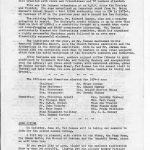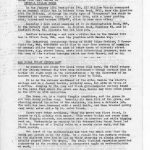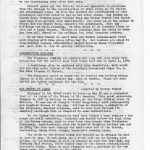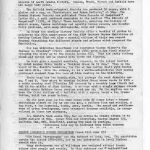Page 1
The 13th Annual General Meeting
This took place on 7th May at Central Library. Vice-President Daisy Hill presided with charm and friendliness and 72 members attended.
This was the largest attendance at an AGM since the society was founded. Its size underlines an important point from Mr Brian Jarman’s annual report — that HADAS membership rose to 234 in 1973-4, an increase of 60 on the previous year and a record for the Society.
The retiring treasurer, Mr Richard Deacon, also had a healthy situation to report. The Society’s credit balance is up by more than £120 on that of 1972-3 — a comforting thought at the moment when costs are leap-frogging and HADAS commitments increasing. Mr Deacon particularly thanked his fund-raising committee, which had organised a highly successful Christmas party followed by an even more financially successful Minimart.
The highlights of the year, as Mr Sammes mentioned in his Research Committee Report, were the Church Terrace excavation and the Archaeology in the Borough Exhibition; both he and Mr Jarman mentioned also the continuing work done by members on many other projects which form the solid background of the Society’s research and endeavour.
After business was over, members enjoyed coffee (thanks to good the staff-work by Elizabeth Holiday and Dorothy Newbury and co-operation from the Library) and three short talks, with excellent slides, given by Daphne Lorimer (on Skara Brae), Ted Sammes (on his recent visit to Turkey) and Eric Wookey (on some splendid Doric temples in Sicily and Greece).
The Officers and Committee elected for 1974-5 are:
Chairman – Mr. Brian Jarman
Vice-Chairman – Mr. Edward Sammes
Hon. Secretary – Mrs. Brigid Grafton Green
Hon. Treasurer – Mr. Jeremy Clynes
Committee: Mrs. Christine Arnott Mrs. Dorothy Newbury
Mr. Michael Bird Mrs. Nell Penny
Mr. G. M. T. Corlet Miss Ann Trewick
Mr. John Enderby Miss Joanna Wade
Mr. Eric Grant Mrs. Freda Wilkinson
Miss Elizabeth Holliday Mr. E. E. Wookey
Mrs. Daphne Lorimer
June Outing
On Saturday, June 15th, Ted Sammes will be taking our members to Bath for the second summer outing.
A full day is planned, with visits to the Abbey, the Pump Room, the Roman Baths, the Museum of Costume and the Assembly Rooms, where we will have tea.
If you would like to come, please use the enclosed application form as soon as possible. (Anyone who has already booked verbally is asked to confirm their booking, with remittance.)
The May outing was heavily overbooked, and our Programme Secretary, Dorothy Newbury, had to open a reserve list. She therefore reminds members that only the first 51 members to apply for Bath can be accommodated. Any member who wishes to bring a husband/wife/friend who is not a member may do so; but any non-members, unaccompanied by a member, will be able to book only after all members have been fitted in.
Page 2
And, looking ahead, don’t forget these dates for the future:
Saturday 13th July – Danebury hill-fort and Rockbourne Roman villa
Saturday 14th Sept – Compton Wyngates and Wormleighton Deserted Medieval village.
Unusual Pillar Boxes
Notes from Paul Carter.
In the January 1973 newsletter (No. 23) William Morris commented on an unusual pillar box in Golders Green Road, NW11, near the junction with the Ridings. Although the early type your “Anonymous” which he described is uncommon, there is a later type, with a lower posting slot, introduced between 1883-87, which is seen more often.
Recently I have noted examples of it in Sunningfields Road, NW4, by the Nursery Walk junction; in Station Road, Finchley, N3, and in Elmfield Road, N2, opposite the Red Lion pub.
Another interesting — and rare — pillar box is the Edward VIII box in Elliott Road, NW4, near the junction with Hendon Way.
The Industrial Archaeology Group of HADAS (Alec Jeakins) would like to hear from members of examples of unusual pillar boxes and also of other types of historic street furniture, e.g. street lamps, seats with interesting iron work, such as the arms of the various Boroughs which now form Barnet, and so on.
Has HADAS found Hendon Man?
As members who study the local press will know, the final stages of the Church Terrace dig had been enlivened — though perhaps that is hardly the right word in the circumstances — by the discovery of an ancient human burial, the first ever found by HADAS.
It is on the extreme north west of the site, beside the clerk’s cottage and is a formal burial, probably male, but with no trace of a coffin. Judging by the grey and black grit-tempered pottery found in the level from which the grave was dug, burial may have taken place in the 13th or 14th centuries.
The bones are in a highly fragile condition, and the grave is cut into heavy yellow clay. Removing the dark fill of the grave, and clearing around the sides of the skeleton, has been a delicate job. The soil has been loosened with a small knife, and then brushed gently away using water and a 1 1/2 inch paint brush.
There were other problems. When the grave was first found, it tended to fill quickly with water. This meant bailing out every time before digging started, and sponges were in constant use while digging went on. Fortunately an inquiry to the Metropolitan Water Board led to the discovery of a faulty valve on a nearby water main, and the flood ceased.
Not least of the difficulties was that the skull went into the baulk and almost under the road. As a result the two members working on the skeleton have had to lie on their stomachs on planks strategically placed above the grave. The whole ticklish operation provided passers-by in the roadway with an unexpected angle on archaeologists at work.
As the Newsletter goes to press a second burial has begun to be uncovered some 4 yards from the first. At the moment only the long bones of the legs and the bones of the feet are visible. A dark outline in the clay between the two known burials suggests that a third may be awaiting discovery.
Why these burials should lie outside the churchyard of Hendon St. Mary’s is still a mystery. In medieval times the Church consisted of the present Lady Chapel, and the churchyard is likely to have been smaller in area than it is today, so there is no doubt that these graves were outside consecrated ground.
Page 3
As announced in the last Newsletter, the Church Terrace dig ends officially on 31st May, although through the kind co-operation of the Borough Architect’s Department it may be possible to finish one or two outstanding jobs after that date.
Several years ago the Society obtained agreement in principle from the Borough to the investigation of other sites in the Church End development area. We have now applied for ratification of that permission and have asked to dig at two other sites. One fronts on Church Road, between Sunny Gardens Road and Fuller Street (the buildings here have already been demolished); the other is on the corner of Church End and Church Road, opposite the almshouses. On both sites it is intended first to take out a trial trench. Whether we continue with the sites or abandon them will depend on the evidence the trial trenches produce.
So at this moment we can’t make any formal announcement about what digging will be played take place after May 31st; but members are asked to ring Dorothy Newbury or Brigid Grafton Green who will both be able to provide information.
Subscription Reminder
The Treasurer reminds all members who have not paid their subscriptions for the current year that these fell due on 1 April 1974.
A remittance slip is enclosed with this Newsletter, with which you can also order copies of the Society’s Occasional Paper No. 2, The Blue Plaques of Barnet.
Our Treasurer would be happy too to receive any trading stamps (green or pink) which members may care to donate. These are most useful for buying equipment for the dig.
May outing to Lewes
Reported by George Ingram.
Highspot of the HADAS visit to Lewes on May 18th was a conducted tour of the ruins of the priory of St. Pancras. In this great monastery, founded in 1077 by William de Warenne, was the first Cluinaic house in Britain. It was one of Cluny’s “elder daughters”, with subsequently six daughter houses of its own. William de Warenne, a companion of the Conqueror, married Gundrada, said to have been William I’s daughter (although this is disputed by some authorities).
In its heyday the monastery must have formed a vast complex — its ruins are still extensive. Gundrada was buried before the high altar of the Priory Church, said to have been even larger than Chichester Cathedral; unfortunately, when The Lewis to Brighton railway was cut in 1845, the line went through the whole East End of the church, destroying, among other things, Gundrada’s resting place.
Our guide to the Priory ruins had briefed us in advance on what we were to see. He had given us a short talk on the Priory, with slides, in the morning, as well as showing us over the Town Hall and Barbican Hall Museum, which houses many of the Sussex Archaeological Society’s finds. There we were favoured with a preview of the new Roman room, not yet open to the public.
After visiting the Priory in the afternoon the party split into two groups. One walked over the Downs to see the excavation of a Bronze Age barrow; the other took in Lewes Castle and the Ann of Cleves Museum.
After tea at the 15th century Bull House — where Tom Paine (1739-1808) the English-born radical writer and politician once lived — we started for home. On the coach a warm vote of thanks was given to Rosalind Elliston and Pip Saunders for organising the successful outing; and one of our younger members, Marion Newbury, ran a raffle to help with the expenses of the trip. “Ran” is the operative word, as she distributed to prizes in a series of sprints up and down the gangway of the coach!
Page 4
Local History in North London
The last six months have produced a spate of booklets on different aspects of North London history. Camden, Brent, Barnet and Enfield have all leapt into print.
The Enfield Archaeological Society has produced 32 pages, with 2 plates and a map, on “Prehistoric and Roman Enfield”, at £0.50. The Camden History Society has published “More Streets of Hampstead” (price £1), a well produced companion to its earlier “The Streets of Hampstead” (1972, at £0.75). These booklets, covering the history of street names, famous buildings and equally famous owners are beautifully produced, with many photographs maps and plans.
In Brent the Wembley History Society offer a booklet of photographs to celebrate the 50th anniversary of the 1924 British Empire Exhibition at Wembley (price £0.75) and also a special edition of their roneod Journal describing the different stands and palaces which composed the exhibition.
Our own Libraries Department has reprinted George Wilmot’s “The Railway in Finchley” (first published 1962) with a new final chapter bringing the story up to the minute (price £1). This has early railway plans and photos and is packed with facts and figures.
We must give a special accolade, however, to the latest booklet by HADAS member Clive Smith — “Golders Green As It Was”. This is the third of Mr Smith’s booklets, the first two having dealt with Hendon and Mill Hill. Like the others, it is a words-and-pictures (but mostly pictures) account from the turn of the century to the mid 1920s.
Every page has its fascination, but perhaps the most dramatic are pages 8 and 9. They start by showing Golders Green crossroads in 1904 — a muddy country road (Finchley Road) crossed by a country lane (North End Road) in the middle of flat fields. A cottage with a single chimney stands roughly where Golders Green Station yard now is. On the skyline can be seen the faint outline of a building with a square tower — the Crematorium, built two years before.
On the next page is the same scene only 20 years later — houses stretching almost as far as the eye can see, the railway line and station, a bus yard, a War Memorial, banks, cars, bustle. The speed and ruthlessness of urban development, once transport becomes available, is encapsulated in these two pictures.
Mr Smith’s book costs £0.65, but as before he kindly offers it to HADAS members at £0.50. Order from librarian, George Ingram, sending £0.50 plus 6p postage.
Church Farm House Museum Exhibition
(Open till 23 June)
“Old Local Photographs” are the subject of this, too. The exhibition covers the period 1865-1920, and no one interested in local history should miss it.
Many photographs are of buildings now vanished without trace; others show people and events. In this category are 8 unidentified groups. The Library would be delighted if any HADAS member can offer a clue as to the occasion or the identity of the individuals in the photos. Any suggestions, please, to our Hon. Secretary.
Correction
In the article on Laurel Farm in the last Newsletter, the central sentence in the third paragraph should read “This type of churn was still in production in 1930” — not 1830, has printed.





